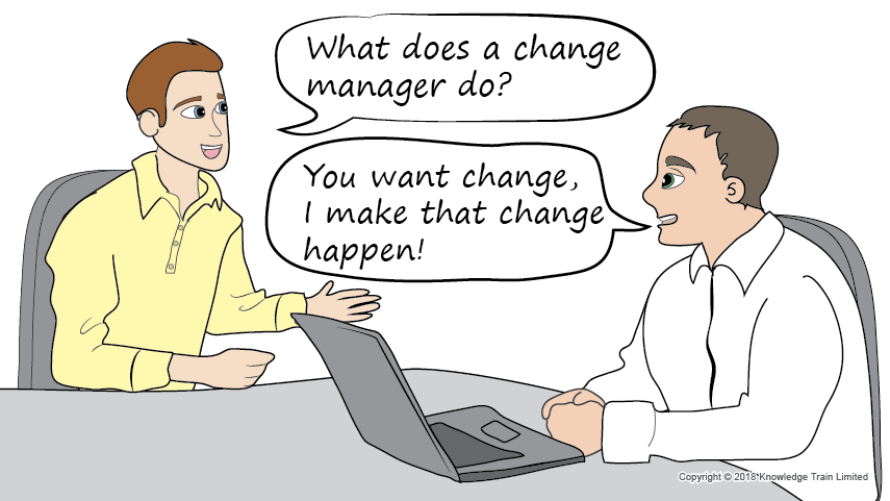
Introduction

Definition of change management
Change management is the act of transitioning an organisation from an existing situation (or current state) to a situation providing more desirable outcomes (a future state). It requires teamwork, hard work, and best practise change management tools and processes to reach the future state.
Applying change in organisations requires optimism, determination and dedication. Therefore, a person must oversee the change strategy and be able to drive it to its proper destination. That person is the change manager.
Many change managers learn the key change management tools and techniques by attending one of these professional change management courses. In the UK, the most popular of these are the APMG change management courses.
Why organisations use change managers
Change managers play a significant role in the success of change initiatives as they direct the desired outcomes down the right path. They do this using best practices and customising such practices to the organisation’s culture. Better performance from staff, improved ways of working and higher sales targets are some of the outcomes we can tangibly see.
Here are some findings after change management was implemented in companies lead by a change manager:
- According to IBM, the success rate of change projects using a dedicated change manager rose by 19% compared to those that did not.
- ChangeFirst Limited say that six to nine months after project launch, projects with change management input were delivering significant performance improvements, financial results and behavioural change. Most of the respondents attributed over 20% of the success directly to effective change management.
- Ferris stated that effective change management delivers improved adoption speed, utilization rate and employee proficiency, stressing the importance of effective preparation for change, disciplined management, and clear reinforcement.
- Prosci mentioned that change management programmes rated ‘good’ or ‘excellent’ had an above-80% success rate. Those rated ‘poor’ or ‘fair’ achieve less than 50%[1].

What a change manager does
A change manager manages the change portfolio. Some of their responsibilities are:
- Identifying, analysing and preparing risk mitigation tactics
- Identifying and managing anticipated resistance
- Integrating change management activities into a project plan
- Evaluating and ensuring user readiness
They perform change management by:
- Completing change management assessments
- Defining and measuring success metrics and monitoring change progress
- Supporting organisational design and definition of roles and responsibilities
- Creating communications plan, sponsor roadmap, coaching plan, training plan, resistance management plan
And other people involved are:
- Stakeholders
- Senior leaders, managers and supervisors
- HR Personnel
- Project leaders and teams
- Other specialists related with the change plans [2]
Starting a change manager career
Experience
Firstly, you probably need to have at least on-the-job experience in a management role in a corporate environment. The reason for this is because it helps you understand the complexity of individuals, teams, and senior leaders’ issues. You will need to know how to mediate between these different people and their departments’ needs to achieve the change you are assigned to.
If you are in an entry level or junior position, you can check if your organisation offers change agent roles. These roles will help you comprehend and take part of the change process and eventually gain experience in the change cycle.
Domain knowledge
In addition to that, industry knowledge is important. You are expected to at least know the products and services your company sells and reflect that in your change plan. A fashion house will be different from a car selling company, for example. The internal and external structure of both are completely different and should be taken into consideration.
This applies also to profession. If your background/study area is Human Resources Management, and you are assigned to initiate change in the Information Technology department, you must familiarise yourself in IT before making any further steps.
Qualifications
If you haven’t studied change management before, accredited certifications like these APMG Change Management courses can help boost your credentials and learn the frameworks and models to implement change management. Courses like these will teach you:
- Different professional approaches to implement change smoothly
- How to motivate people into adjusting to organisational change
- How to minimise the risks of unsuccessful methods
You will stumble across change management in other branches of management like project management, programme management and ITIL as change plays an imperative role there.
Competencies
A range of skills is required to facilitate the wanted change and function effectively as a change manager. Such skills include:
Strong communication skills
It is essential for a change manager to be able to communicate clearly and effectively in all writing, speaking, listening and reading activities. They must be able to deliver their change message to all stakeholders involved.
Influencing others
A big part of change is the ability to influence others, as resistance plays a big factor in the change curve. When you know the team members of your change project well, it will help you negotiate and convince them with the original reason for change and thus gain their trust.
Coaching skills
You can’t assume that everybody in the company will understand your change mission. Hence, meetings like awareness sessions, in-house training and one-to-one mentoring will be needed to deliver your message.
Strategic thinking and judgment
It is not recommended to jump into conclusions and rush into decisions while you are a change manager. You must be able to think ahead and weigh the consequences of your actions.
Project management
Putting on a project manager’s hat while working on your change initiative will help strengthen your case and identify the problem while proposing a solution.
Self-management
Along with your ability to manage your team, you will have to manage yourself as well. What we mean by this is being able to take initiative, organise your time/workload and take accountability for your actions. In addition to these, you must also be able to control your emotions and be tolerant and confident.
Summary
As we mentioned before, change isn’t easy. It takes a lot of momentum, resilience and persistence. Being a change manager means you will need to sell the change to the individuals around you, your stakeholders, your team members, the project and the whole organisation, and eventually yourself.

Once you enter the change zone, you will have to commit to it to the very end. Thus, preparation is key to your success!
To be fully ready and equipped for your journey as a change manager, a good start is to enrol on a 3-day Change Management Foundation course, or a 5-day Change Management Foundation and Practitioner course. These are accredited by APMG in partnership with the Change Management Institute (CMI).
Contact Knowledge Train today to book your seat!
References
[1] The Change Management Institute (CMI) (2014). The Effective Change Manager’s Handbook. Australia: Vivid Publishing. 4-5
[2] Prosci. (Unknown). Change Management Job Description. Available: https://www.prosci.com/resources/articles/change-management-job-description. Last accessed 22 Oct 2018.







